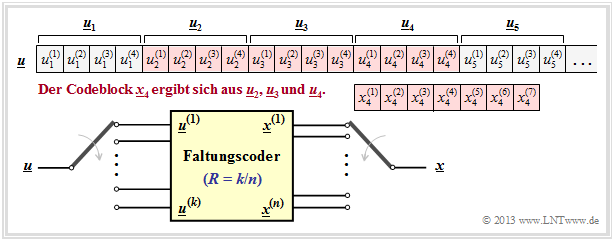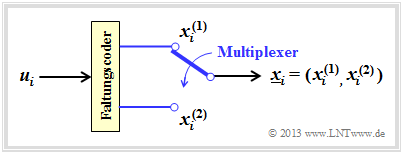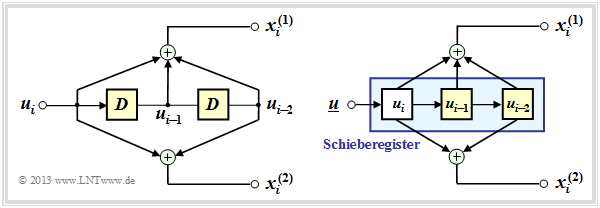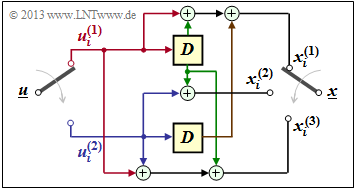Difference between revisions of "Channel Coding/Basics of Convolutional Coding"
| Line 64: | Line 64: | ||
*For $k > 1$ one often gives these parameters also in bits: $m_{\rm Bit} = m \cdot k$ resp. $\nu_{\rm Bit} = (m + 1) \cdot k$.<br>}} | *For $k > 1$ one often gives these parameters also in bits: $m_{\rm Bit} = m \cdot k$ resp. $\nu_{\rm Bit} = (m + 1) \cdot k$.<br>}} | ||
| − | == | + | == Similarities and differences compared to block codes == |
<br> | <br> | ||
| − | + | From the [[Channel_Coding/Basics_of_Convolutional_Coding#Requirements_and_definitions| "definition"]] on the previous page, it is evident that a binary convolutional code with $m = 0$ (i.e., without memory) would be identical to a binary block code as described in the first main chapter. We exclude this limiting case and therefore always assume for the following: | |
| − | * | + | *The memory $m$ be greater than or equal to $1$.<br> |
| − | * | + | *The influence length $\nu$ be greater than or equal to $2$.<br><br> |
{{GraueBox|TEXT= | {{GraueBox|TEXT= | ||
| − | $\text{ | + | $\text{Example 1:}$ For a $(7, 4)$ block code, the codeword $\underline {x}_4$ depends only on the information word $\underline{u}_4$ but not on $\underline{u}_2$ and $\underline{u}_3$, as in the [[Channel_Coding/Basics_of_Convolutional_Coding#Requirements_and_definitions| "example convolutional codes"]] $($with $m = 2)$ on the last page.<br> |
| − | [[File:P ID2592 KC T 3 1 S2 v2.png|right|frame| | + | [[File:P ID2592 KC T 3 1 S2 v2.png|right|frame|Dependencies on a $(7, 4)$ block code at time $i = 4$|class=fit]] |
| − | + | For example, if | |
:$$x_4^{(1)} = u_4^{(1)}, \ x_4^{(2)} = u_4^{(2)},$$ | :$$x_4^{(1)} = u_4^{(1)}, \ x_4^{(2)} = u_4^{(2)},$$ | ||
:$$x_4^{(3)} = u_4^{(3)}, \ x_4^{(4)} = u_4^{(4)}$$ | :$$x_4^{(3)} = u_4^{(3)}, \ x_4^{(4)} = u_4^{(4)}$$ | ||
| Line 84: | Line 84: | ||
:$$x_4^{(7)} = u_4^{(1)}+ u_4^{(2)}+u_4^{(4)}\hspace{0.05cm},$$ | :$$x_4^{(7)} = u_4^{(1)}+ u_4^{(2)}+u_4^{(4)}\hspace{0.05cm},$$ | ||
| − | so | + | applies then it is a so-called [[Channel_Coding/Examples_of_Binary_Block_Codes#Hamming_Codes| "systematic Hamming code"]] $\text{HS (7, 4, 3)}$. In the graph, these special dependencies for $x_4^{(1)}$ and $x_4^{(7)}$ are drawn in red.}}<br> |
| − | In | + | In a sense, one could also interpret a $(n, k)$ convolutional code with memory $m ≥ 1$ as a block code whose code parameters $n\hspace{0.05cm}' \gg n$ and $k\hspace{0.05cm}' \gg k$ however, would have to assume much larger values than those of the present convolutional code. However, because of the large differences in description, properties, and especially decoding, we consider convolutional codes to be something completely new in this learning tutorial. The reasons for this are as follows: |
| − | * | + | *A block coder converts information words of length $k$ bits into code words of length $n$ bits each, block by block. In this case, the larger its codeword length $n$ is, the more powerful the block code is. For a given code rate $R = k/n$ this also requires a large information word length $k$.<br> |
| − | * | + | *In contrast, the correction capability of a convolutional code is essentially determined by its memory $m$ . The code parameters $k$ and $n$ are mostly chosen very small here $(1, \ 2, \ 3, \ \text{...})$. Thus, only very few and, moreover, very simple convolutional codes are of practical importance.<br> |
| − | * | + | *Even with small values for $k$ and $n$ a convolutional encoder transfers a whole sequence of information bits $(k\hspace{0.05cm}' → ∞)$ into a very long sequence of code bits $(n\hspace{0.05cm}' = k\hspace{0.05cm}'/R)$. Such a code thus often provides a large correction capability as well.<br> |
| − | * | + | *There are efficient convolutional decoders, for example the [[Channel_Coding/Decodierung_von_Faltungscodes#Viterbi.E2.80.93Algorithmus.2C_basierend_auf_Korrelation_und_Metriken| "Viterbi algorithm"]] and the [[Channel_Coding/Soft%E2%80%93in_Soft%E2%80%93out_Decoder#BCJR.E2.80.93Decodierung:_Vorw.C3.A4rts.E2.80.93R.C3.BCckw.C3.A4rts.E2.80.93Algorithmus| "BCJR algorithm"]], which can process reliability information about the channel ⇒ ''Soft–Decision–Input'' and provide reliability information about the decoding result ⇒ <i>Soft–Decision–Output</i> .<br> |
| − | == | + | == Rate 1/2 convolutional encoder == |
<br> | <br> | ||
| − | [[File:P ID2593 KC T 3 1 S3a v1.png|right|frame| | + | [[File:P ID2593 KC T 3 1 S3a v1.png|right|frame|Convolutional encoder $(n = 2, \hspace{0.05cm} k = 1)$ for one information bit $u_i$|class=fit]] |
| − | + | ||
| − | |||
Revision as of 20:01, 19 September 2022
Contents
# OVERVIEW OF THE THIRD MAIN CHAPTER #
This third main chapter discusses Convolutional codes, first described in 1955 by "Peter Elias" [Eli55][1]. While for linear block codes (see "First Main Chapter") and Reed-Solomon codes (see "Second main chapter") the codeword length is $n$ in each case, the theory of convolutional cdes is based on "semi-infinite" information and code sequences. Similarly, maximum likelihood decoding using the Viterbi algorithm per se yields the entire sequence.
Specifically, this chapter discusses:
- Important definitions for convolutional codes: code rate, memory, influence length, free distance.
- Similarities and differences to linear block codes,
- generator matrix and transfer function matrix of a convolutional code,
- Fractional-rational transfer functions for systematic convolutional codes,
- Description with state transition diagram and trellis diagram,
- termination and puncturing of convolutional codes,
- decoding of convolutional codes ⇒ Viterbi algorithm,
- weight enumerator functions and approximations for the bit error probability.
Requirements and definitions
We consider in this chapter an infinite binary information sequence $\underline{u}$ and divide it into information blocks $\underline{u}_i$ of $k$ bits each. One can formalize this fact as follows:
- \[\underline{\it u} = \left ( \underline{\it u}_1, \underline{\it u}_2, \hspace{0.05cm} \text{...} \hspace{0.05cm}, \underline{\it u}_i , \hspace{0.05cm} \text{...} \hspace{0.05cm}\right ) \hspace{0.3cm}{\rm mit}\hspace{0.3cm} \underline{\it u}_i = \left ( u_i^{(1)}, u_i^{(2)}, \hspace{0.05cm} \text{...} \hspace{0.05cm}, u_i^{(k)}\right )\hspace{0.05cm},\]
- \[u_i^{(j)}\in {\rm GF(2)}\hspace{0.3cm}{\rm for} \hspace{0.3cm}1 \le j \le k \hspace{0.5cm}\Rightarrow \hspace{0.5cm} \underline{\it u}_i \in {\rm GF}(2^k)\hspace{0.05cm}.\]
In English, such a sequence without negative indices is called semi–infinite .
$\text{Definition:}$ In a Binary Convolutional Code, a codeword $\underline{x}_i$ consisting of $n$ code bit is output at time $i$ :
- \[\underline{\it x}_i = \left ( x_i^{(1)}, x_i^{(2)}, \hspace{0.05cm} \text{...} \hspace{0.05cm}, x_i^{(n)}\right )\in {\rm GF}(2^n)\hspace{0.05cm}.\]
This results according to
- the $k$ bit of the current information block $\underline{u}_i$, and
- the $m$ previous information blocks $\underline{u}_{i-1}$, ... , $\underline{u}_{i-m}$.
The diagram opposite illustrates this fact for the parameters $k = 4, \ n = 7, \ m = 2$ and $i = 4$.
The $n = 7$ code bits generated at time $i = 4$ $x_4^{(1)}$, ... , $x_4^{(7)}$ may depend (directly) on the $k \cdot (m+1) = 12$ information bits marked in red and are generated by modulo 2 additions.
Also drawn in yellow is a $(n, k)$ convolutional encoder. Note that the vector $\underline{u}_i$ and the sequence $\underline{u}^{(i)}$ are fundamentally different:
- While $\underline{u}_i = (u_i^{(1)}, u_i^{(2)}$, ... , $u_i^{(k)})$ summarizes $k$ at time $i$ parallel information bits,
- denotes $\underline{u}^i = (u_1^{(i)}$, $u_2^{(i)}, \ \text{...})$ the (horizontal) sequence at $i$–th input of the convolutional encoder.
$\text{Definitions related to convolutional codes:}$
- The code rate results as for the block codes to $R = k/n$.
- Perceive $m$ as the memory of the code and the convolutional code itself with ${\rm CC} \ (n, k, m)$.
- This gives the constraint length $\nu = m + 1$.
- For $k > 1$ one often gives these parameters also in bits: $m_{\rm Bit} = m \cdot k$ resp. $\nu_{\rm Bit} = (m + 1) \cdot k$.
Similarities and differences compared to block codes
From the "definition" on the previous page, it is evident that a binary convolutional code with $m = 0$ (i.e., without memory) would be identical to a binary block code as described in the first main chapter. We exclude this limiting case and therefore always assume for the following:
- The memory $m$ be greater than or equal to $1$.
- The influence length $\nu$ be greater than or equal to $2$.
$\text{Example 1:}$ For a $(7, 4)$ block code, the codeword $\underline {x}_4$ depends only on the information word $\underline{u}_4$ but not on $\underline{u}_2$ and $\underline{u}_3$, as in the "example convolutional codes" $($with $m = 2)$ on the last page.
For example, if
- $$x_4^{(1)} = u_4^{(1)}, \ x_4^{(2)} = u_4^{(2)},$$
- $$x_4^{(3)} = u_4^{(3)}, \ x_4^{(4)} = u_4^{(4)}$$
sowie
- $$x_4^{(5)} = u_4^{(1)}+ u_4^{(2)}+u_4^{(3)}\hspace{0.05cm},$$
- $$x_4^{(6)} = u_4^{(2)}+ u_4^{(3)}+u_4^{(4)}\hspace{0.05cm},$$
- $$x_4^{(7)} = u_4^{(1)}+ u_4^{(2)}+u_4^{(4)}\hspace{0.05cm},$$
applies then it is a so-called "systematic Hamming code" $\text{HS (7, 4, 3)}$. In the graph, these special dependencies for $x_4^{(1)}$ and $x_4^{(7)}$ are drawn in red.
In a sense, one could also interpret a $(n, k)$ convolutional code with memory $m ≥ 1$ as a block code whose code parameters $n\hspace{0.05cm}' \gg n$ and $k\hspace{0.05cm}' \gg k$ however, would have to assume much larger values than those of the present convolutional code. However, because of the large differences in description, properties, and especially decoding, we consider convolutional codes to be something completely new in this learning tutorial. The reasons for this are as follows:
- A block coder converts information words of length $k$ bits into code words of length $n$ bits each, block by block. In this case, the larger its codeword length $n$ is, the more powerful the block code is. For a given code rate $R = k/n$ this also requires a large information word length $k$.
- In contrast, the correction capability of a convolutional code is essentially determined by its memory $m$ . The code parameters $k$ and $n$ are mostly chosen very small here $(1, \ 2, \ 3, \ \text{...})$. Thus, only very few and, moreover, very simple convolutional codes are of practical importance.
- Even with small values for $k$ and $n$ a convolutional encoder transfers a whole sequence of information bits $(k\hspace{0.05cm}' → ∞)$ into a very long sequence of code bits $(n\hspace{0.05cm}' = k\hspace{0.05cm}'/R)$. Such a code thus often provides a large correction capability as well.
- There are efficient convolutional decoders, for example the "Viterbi algorithm" and the "BCJR algorithm", which can process reliability information about the channel ⇒ Soft–Decision–Input and provide reliability information about the decoding result ⇒ Soft–Decision–Output .
Rate 1/2 convolutional encoder
Die Begriffe "Faltungscodierer" und "Faltungscode" sollte man allerdings nicht verwechseln.
- Unter einem Faltungscode ${\rm CC} \ (n, \ k, \ m)$ ⇒ $R = k/n$ versteht man die Menge aller möglichen Codesequenzen $\underline{x}$, die mit diesem Code unter Berücksichtigung aller möglichen Informationssequenzen $\underline{u}$ (am Eingang) generiert werden kann.
- Es gibt verschiedene Faltungscodierer, die den gleichen Faltungscode realisieren.
Die obere Grafik zeigt einen $(n = 2, \hspace{0.05cm} k = 1)$–Faltungscodierer.
- Zum Taktzeitpunkt $i$ liegt das Informationsbit $u_i$ am Codereingang an und es wird der 2–Bit–Codeblock $\underline{x}_i = (x_i^{(1)}, \ x_i^{(2)})$ ausgegeben.
- Unter Berücksichtigung der (halb–unendlich) langen Informationssequenz $\underline{u}$ ergibt sich das Modell entsprechend der zweiten Grafik.
- Um aus einem einzigen Informationsbit $u_i$ zwei Codebit $x_i^{(1)}$ und $x_i^{(2)}$ generieren zu können, muss der Faltungscodierer mindestens ein Speicherelement beinhalten:
- $$k = 1\hspace{0.05cm}, \ n = 2 \hspace{0.3cm}\Rightarrow \hspace{0.3cm} m \ge 1 \hspace{0.05cm}.$$
$\text{Beispiel 2:}$ Nachfolgend ist ein Faltungscodierer für die Parameter $k = 1, \ n = 2$ und $m = 1$ dargestellt. Das gelb hinterlegte Quadrat kennzeichnet ein Speicherelement. Dessen Beschriftung $D$ ist von Delay abgeleitet.
- Es handelt sich hier um einen systematischen Faltungscodierer, gekennzeichnet durch $x_i^{(1)} = u_i$.
- Der zweite Ausgang liefert $x_i^{(2)} = u_i + u_{i-1}$.
- In der beispielhaften Ausgangssequenz $\underline{x}$ nach Multiplexing sind alle $x_i^{(1)}$ rot und alle $x_i^{(2)}$ blau beschriftet.
$\text{Beispiel 3:}$ Die Grafik zeigt einen $(n = 2, \ k = 1)$–Faltungscodierers mit $m = 2$ Speicherelementen:
- Links ist das Ersatzschaltbild dargestellt.
- Rechts ist eine Realisierungsform dieses Coders angegeben.
- Die beiden Informationsbits lauten:
- \[x_i^{(1)} = u_{i} + u_{i-1}+ u_{i-2} \hspace{0.05cm},\]
- \[x_i^{(2)} = u_{i} + u_{i-2} \hspace{0.05cm}.\]
- Wegen $x_i^{(1)} ≠ u_i$ handelt es sich hier nicht um einen systematischen Code.
Man erkennt:
- Die Informationssequenz $\underline{u}$ wird in einem Schieberegister der Länge $L = m + 1 = 3$ abgelegt.
- Zum Taktzeitpunkt $i$ beinhaltet das linke Speicherelement das aktuelle Informationsbit $u_i$, das zu den nächsten Taktzeitpunkten jeweils um eine Stelle nach rechts verschoben wird.
- Aus der Anzahl der gelben Quadrate ergibt sich wieder das Gedächtnis $m = 2$ des Coders.
Aus den beiden Darstellungen wird deutlich, dass $x_i^{(1)}$ und $x_i^{(2)}$ jeweils als der Ausgang eines Digitalen Filters über dem Galoisfeld ${\rm GF(2)}$ interpretiert werden kann, wobei beide Filter parallel mit der gleichen Eingangsfolge $\underline{u}$ arbeiten.
Da sich (ganz allgemein) das Ausgangssignal eines Filters aus der Faltung des Eingangssignals mit der Filterimpulsantwort ergibt, spricht man von Faltungscodierung.
Faltungscodierer mit zwei Eingängen
Nun betrachten wir einen Faltungscodierer, der aus $k = 2$ Informationsbits $n = 3$ Codebits generiert.
- Die Informationssequenz $\underline{u}$ wird in Blöcke zu je zwei Bit aufgeteilt.
- Zum Taktzeitpunkt $i$ liegt am oberen Eingang das Bit $u_i^{(1)}$ an und am unteren Eingang $u_i^{(2)}$.
- Für die $n = 3$ Codebits zum Zeitpunkt $i$ gilt dann:
- \[x_i^{(1)} = u_{i}^{(1)} + u_{i-1}^{(1)}+ u_{i-1}^{(2)} \hspace{0.05cm},\]
- \[x_i^{(2)} = u_{i}^{(2)} + u_{i-1}^{(1)} \hspace{0.05cm},\]
- \[x_i^{(3)} = u_{i}^{(1)} + u_{i}^{(2)}+ u_{i-1}^{(1)} \hspace{0.05cm}.\]
In der Grafik sind die Info–Bits $u_i^{(1)}$ und $u_i^{(2)}$ rot bzw. blau gekennzeichnet, und die vorherigen Info–Bits $u_{i-1}^{(1)}$ und $u_{i-1}^{(2)}$ grün bzw. braun.
Anzumerken ist:
- Das Gedächtnis $m$ ist gleich der maximalen Speicherzellenzahl in einem Zweig ⇒ hier $m = 1$.
- Die Einflusslänge $\nu$ ist gleich der Summe aller Speicherelemente ⇒ hier $\nu = 2$.
- Alle Speicherelemente seien zu Beginn der Codierung (Initialisierung ) auf Null gesetzt.
Der hiermit definierte Code ist die Menge aller möglichen Codesequenzen $\underline{x}$, die sich bei Eingabe aller möglichen Informationssequenzen $\underline{u}$ ergeben. Sowohl $\underline{u}$ als auch $\underline{x}$ seien dabei (zeitlich) unbegrenzt.
$\text{Beispiel 4:}$ Die Informationssequenz sei $\underline{u} = (0, 1, 1, 0, 0, 0, 1, 1, \ \text{ ...})$. Daraus ergeben sich die Teilsequenzen $\underline{u}^{(1)} = (0, 1, 0, 1, \ \text{ ...})$ und $\underline{u}^{(2)} = (1, 0, 0, 1, \ \text{ ...})$.
Mit der Festlegung $u_0^{(1)} = u_0^{(2)} = 0$ folgt aus den obigen Gleichungen für die $n = 3$ Codebits
- im ersten Codierschritt $(i = 1)$:
- \[x_1^{(1)} = u_{1}^{(1)} = 0 \hspace{0.05cm},\hspace{0.4cm} x_1^{(2)} = u_{1}^{(2)} = 1 \hspace{0.05cm},\hspace{0.4cm} x_1^{(3)} = u_{1}^{(1)} + u_{1}^{(2)} = 0+1 = 1 \hspace{0.05cm},\]
- im zweiten Codierschritt $(i = 2)$:
- \[x_2^{(1)} =u_{2}^{(1)} + u_{1}^{(1)}+ u_{1}^{(2)} = 1 + 0 + 1 = 0\hspace{0.05cm},\hspace{0.4cm} x_2^{(2)} = u_{2}^{(2)} + u_{1}^{(1)} = 0+0 = 0\hspace{0.05cm},\hspace{0.4cm} x_2^{(3)} = u_{2}^{(1)} + u_{2}^{(2)}+ u_{1}^{(1)} = 1 + 0+0 =1\hspace{0.05cm},\]
- im dritten Codierschritt $(i = 3)$:
- \[x_3^{(1)} =u_{3}^{(1)} + u_{2}^{(1)}+ u_{2}^{(2)} = 0+1+0 = 1\hspace{0.05cm},\hspace{0.4cm} x_3^{(2)} = u_{3}^{(2)} + u_{2}^{(1)} = 0+1=1\hspace{0.05cm},\hspace{0.4cm} x_3^{(3)} =u_{3}^{(1)} + u_{3}^{(2)}+ u_{2}^{(1)} = 0+0+1 =1\hspace{0.05cm},\]
- und schließlich im vierten Codierschritt $(i = 4)$:
- \[x_4^{(1)} = u_{4}^{(1)} + u_{3}^{(1)}+ u_{3}^{(2)} = 1+0+0 = 1\hspace{0.05cm},\hspace{0.4cm} x_4^{(2)} = u_{4}^{(2)} + u_{3}^{(1)} = 1+0=1\hspace{0.05cm},\hspace{0.4cm} x_4^{(3)}= u_{4}^{(1)} + u_{4}^{(2)}+ u_{3}^{(1)} = 1+1+0 =0\hspace{0.05cm}.\]
Damit lautet die Codesequenz nach dem Multiplexer: $\underline{x} = (0, 1, 1, 0, 0, 1, 1, 1, 1, 1, 1, 0, \ \text{...})$.
Aufgaben zum Kapitel
Aufgabe 3.1: Analyse eines Faltungscodierers
Aufgabe 3.1Z: Faltungscodes der Rate 1/2
Quellenverzeichnis
- ↑ Elias, P.: Coding for Noisy Channels. In: IRE Conv. Rec. Part 4,pp. 37-47, 1955.






